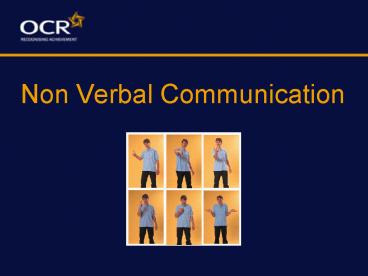Non Verbal Communication PowerPoint PPT Presentation
1 / 20
Title: Non Verbal Communication
1
Non Verbal Communication
2
What does the following sign mean to you?
3
- In most of Europe and in the USA, the previous
sign symbolises the word ok. - However, in other cultures it means something
different. - For example, in Japan it can mean money.
- In countries such as Germany, it is used
offensively (in the same way 2 fingers are in the
UK). - In Brazil the sign has a sexual meaning.
4
Cross-Cultural Differences in Non Verbal
Communication
- In the same way that different cultures may
interpret hand gestures differently, they may
also interpret facial expressions differently. - Not all psychologists agree with this. Some argue
that facial expressions are universal. By this,
they mean facial expressions are perceived in the
same way by everybody around the world.
5
Testing Universialities
- Look at the following faces.
- Can you decide what kind of emotion each one is
expressing?
6
Universialities in NVC
- You should find that you interpreted the emotions
similarly to other people. Indeed, research
suggests that you would interpret them similarly
to people from other cultures too. - However, there may be more differences when you
have to decide on the degree of emotion.
7
Testing Universialities
- Look at the following faces.
- Can you decide who is the angriest?
8
Differences in NVC
- You may have just found some differences between
how you interpreted the previous faces and how
others did. - Differences in interpretation can be even more
marked between cultures. In other words,
different cultures may be socialised to interpret
faces differently.
9
Differences in Emotional Expression
- - )
- Many people use the above symbols when signing of
texts or e-mails because they represent a happy
face. - Interestingly, this symbol is not used worldwide.
10
- For example, in Japan, the following symbols are
used to denote a happy face - (ˆ-ˆ)
- The point being, that in Japanese culture eyes
are more important when expressing (and
interpreting) emotions.
11
Core StudyIn Non Verbal Communication
- Yuki, Maddux Masuda (2007)
- Are the windows to the soul the same in the East
and West? - Cultural differences in using eyes and mouth as
cues to recognize emotions in Japan and the
United States.
12
Aim
- Yuki et al wanted to show that how we interpret
facial expressions is a product of our culture
and socialisation.
13
Hypothesis
- They predicted that Japanese people would read
the emotions of faces by using the eyes whereas
American people would read the emotions of faces
by using the mouth.
14
Method
- A cross cultural study was conducted using
students from Japan and comparing them with
students from the USA.
15
Method
- The participants were shown a set of six
emoticons. - Emoticons are simple computer generated faces.
- The emoticons used a different combination of
happy/neutral/sad eyes and mouths.
16
Method
9
- Participants were given a questionnaire.
- They had to rate each of the six faces (between 1
and 9) for how happy it was. - The researchers then worked out the average
rating for each face within each culture.
1
17
Results
Japan
9
USA
average rating
0
18
Results
- As the graph showed, Japanese participants gave
higher ratings to faces with happy eyes than
American participants did. This was especially
true when the mouth was sad. - American participants gave their highest ratings
when the mouths were happy (even when the eyes
were sad). This was not true of Japanese
participants. - Japanese participants gave their lowest ratings
when eyes were sad (and the mouth neutral)
whereas American participants gave their lowest
ratings when mouths were sad (even though eyes
were neutral or even happy).
19
Conclusion
- Japanese and American people do interpret facial
expressions differently. Japanese people pay more
attention to the eyes and American people pay
more attention to the mouth. - Yuki et al suggested that this was a result of
socialisation. They argued that Japanese people
are brought up to hide their emotions more so
have to use the eyes as an indicator of feelings.
20
Evaluation
- Yuki et al used computer generated faces to test
participantsthese are not realistic so findings
may lack ecological validity. - Participants knew they were being tested onso
may have responded to demand characteristics and
not given true responses. - Emotional expression and interpretation are
complex ideasand the researchers may have
over-simplified them by just scoring them on a
simple rating scale. - In both countries, the sample was made up of
studentswho may not have represented younger
and older generations. - The researchers only tested one dimension of
emotion (happy/sad)so their findings may not
generalise to other emotions e.g. anger,
surprise, disgust.

